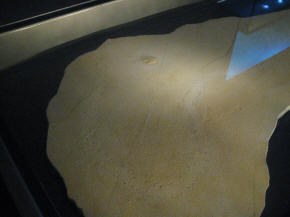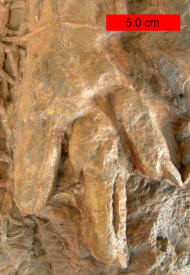The study of traces is called ichnology, which is divided into paleoichnology, or the study of trace fossils, and neoichnology, the study of modern traces. This science is challenging, as most traces reflect the behaviour—not the biological affinity—of their makers. As such, trace fossils are categorised into form genera, based upon their appearance and the implied behaviour of their makers.
Occurrence
Traces are better known in their fossilised form than in modern sediments. This makes it difficult to interpret some fossils by comparing them with modern traces, even though they may be extant or even common. The main difficulties in accessing extant burrows stem from finding them in consolidated sediment, and being able to access those formed in deeper water.
Trace fossils are best preserved in sandstones; the grain size and depositional facies both contributing to the better preservation. They may also be found in shales and limestones.
Information Provided by Ichnofossils
 |
| Mesolimulus walchi fossil and track, a rare example of tracks and the creature that made them fossilized together. Click picture for larger view (Picture Source) |
Because identical fossils can be created by a range of different organisms, trace fossils can only reliably inform us of two things: the consistency of the sediment at the time of its deposition, and the energy level of the depositional environment. Attempts to deduce such traits as whether a deposit is marine or non-marine have been made, but shown to be unreliable.
Paleoecology
Trace fossils provide us with indirect evidence of life in the past, such as the footprints, tracks, burrows, borings, and feces left behind by animals, rather than the preserved remains of the body of the actual animal itself. Unlike most other fossils, which are produced only after the death of the organism concerned, trace fossils provide us with a record of the activity of an organism during its lifetime.
Trace fossils are formed by organisms performing the functions of their everyday life, such as walking, crawling, burrowing, boring, or feeding. Tetrapod footprints, worm trails and the burrows made by clams and arthropods are all trace fossils.
Perhaps the most spectacular trace fossils are the huge, three-toed
footprints produced bydinosaurs and related archosaurs. These imprints give
scientists clues as to how these animals lived. Although the skeletons of
dinosaurs can be reconstructed, only their
fossilized footprints
can determine exactly how they stood and walked. Such tracks can tell much
about the gait of the animal which made them, what its stride was, and
whether or not the front limbs touched the ground.

Eubrontes, a
dinosaur footprint in the Lower Jurassic Moenave Formation at the
St. George Dinosaur Discovery Site at Johnson Farm, southwestern
Utah.
Paleoenvironment
Fossil footprints made by tetrapod vertebrates are difficult to identify to a particular species of animal, but they can provide us with valuable information such as the speed, weight, and behavior of the organism that made them. Such trace fossils are formed when amphibians, reptiles, mammals or birds walked across soft (probably wet) mud or sand which later hardened sufficiently to retain the impressions before the next layer of sediment was deposited. Some fossils can even provide details of how wet the sand was when they were being produced, and hence allow estimation of paleo-wind directions.
Assemblages of trace fossils occur at certain water depths, and can also reflect the salinity and turbidity of the water column.
Stratigraphic correlation
Some trace fossils can be used as local index fossils, to date the rocks in which they are found, such as the burrow Arenicolites franconicus which occurs only in a 4 cm (1.6") layer of the Triassic Muschelkalk epoch, throughout wide areas in southern Germany.
The base of the Cambrian period is defined by the first appearance of the trace fossil Treptichnus pedum.
Trace fossils have a further utility as many appear before the organism thought to create them, extending their stratigraphic range.
Inherent bias
Most trace fossils are known from marine deposits. Essentially, there are two types of traces, either exogenic ones, which are made on the surface of the sediment (such as tracks) or endogenic ones, which are made within the layers of sediment (such as burrows).
Surface trails on sediment in shallow marine environments stand less chance of fossilization because they are subjected to wave and current action. Conditions in quiet, deep-water environments tend to be more favorable for preserving fine trace structures.
Most trace fossils are usually readily identified by reference to similar phenomena in modern environments. However, the structures made by organisms in recent sediment have only been studied in a limited range of environments, mostly in coastal areas, including tidal flats.
Evolution
The earliest complex trace fossils, not including microbial traces such as stromatolites, date to . Putative "burrows" dating as far back as may have been made by animals which fed on the undersides of microbial mats, which would have shielded them from a chemically unpleasant ocean; however their uneven width and tapering ends make a biological origin so difficult to defend that even the original author no longer believes they are authentic.
The first evidence of burrowing
which is widely accepted dates to the
Ediacaran (Vendian)
period, around
.
During this period the traces and burrows basically are horizontal on or
just below the seafloor surface. Such traces must have been made by motile
organisms with heads, which would probably have been
bilateran
animals. The trace
observed imply simple behaviour, and point to organisms feeding above the
surface and burrowing for protection from predators.
Contrary to widely circulated opinion that Ediacaran burrows are only
horizontal the vertical burrows
Skolithos are also
known. The producers of burrows Skolithos
declinatus from the Vendian (Ediacaran) beds in
Russia with date
have not been found, they might have been filter feeders subsisting on the
nutrients from the suspension. The density of these burrows is up to 245
burrows/dm2.
Some Ediacaran trace fossils have been found directly associated with an
body fossils.
Yorgia and
Dickinsonia are often
found at the end of long pathways of trace fossils matching their shape.
The feeding was performed in a mechanical way, supposedly the ventral side
of body these organisms was covered with
cilia. The potential
mollusc related
Kimberella is
associated with scratch marks, perhaps formed by a
radula, further traces
from
appear to imply active crawling or burrowing activity.
Numerous borings in a Cretaceous cobble, Faringdon,
England; see Wilson (1986).
As the Cambrian got underway, new forms of trace fossil appeared, including vertical burrows (e.g. Diplocraterion) and traces normally attributed to arthropods. These represent a “widening of the behavioural repertoire”, both in terms of abundance and complexity.
Trace fossils are a particularly significant source of data from this period because they represent a data source that is not directly connected to the presence of easily-fossilized hard parts, which are rare during the Cambrian. Whilst exact assignment of trace fossils to their makers is difficult, the trace fossil record seems to indicate that at the very least, large, bottom-dwelling, bilaterally symmetrical organisms were rapidly diversifying during the early Cambrian.
Further, less rapid diversification occurred since, and many traces have been converged
| |
| Helminthopsis ichnosp.; a trace fossil from the Logan Formation (Lower Carboniferous) of Wooster, Ohio. |
Trace fossils also provide our earliest evidence of animal life on land. The earliest arthropod trackways date to the Cambro-Ordovician, and trackways from the Ordovician Tumblagooda sandstone allow the behaviour of these organisms to be determined. The enigmatic trace fossil Climactichnites may represent an earlier still terrestrial trace, perhaps made by a slug-like organism.
Other notable trace fossils
Less ambiguous than the above ichnogenera, are the traces left behind by invertebrates such as Hibbertopterus, a giant "sea scorpion" or eurypterid of the early Paleozoic era. This marine arthropod produced a spectacular hibbertopteroid track preserved in Scotland.
Bioerosion through time has produced a magnificent record of borings, gnawings, scratchings and scrapings on hard substrates. These trace fossils are usually divided into macroborings and microborings. Bioerosion intensity and diversity is punctuated by two events. One is called the Ordovician Bioerosion Revolution (see Wilson & Palmer, 2006) and the other was in the Jurassic. For a comprehensive bibliography of the bioerosion literature, please see the External links below.
The oldest types of tetrapod tail-and-foot prints date back to the latter Devonian period. These vertebrate impressions have been found in Ireland, Scotland, Pennsylvania, and Australia.
Important human trace fossils are the Laetoli (Tanzania) footprints, imprinted in volcanic ash 3.7 Ma (million years ago) -- probably by an early Australopithecus.
Importance in the Age of the Earth Debate
Gigandipus, a
dinosaur footprint in the Lower
Jurassic Moenave Formation at the St. George Dinosaur Discovery
Site at Johnson Farm, southwestern Utah.
Trace fossils, especially those of dinosaurs, provide conclusive proof that the earth is not thousands of years old, as young earth creationists claim. Young earth creationists are fond of claiming that the rock layers of the Grand Canyon were deposited during the year-long flood of Noah. They also claim most of the dinosaurs died during the Flood (and that a few were taken on the ark).
The youngest rock layer at the Grand Canyon is the Kaibab Limestone, which is 270 million years old, placing it within the Permian Period, before any dinosaurs existed. This means that all dinosaur trace fossils are younger than the rocks of the Grand Canyon (and younger than Noah's Flood in the young earth belief system). Every evidence contained in the rock layers, which includes dinosaur fossils, tracks, eggs, nests, and fossilized dinosaur dung, is younger than the rocks of the Grand Canyon.
The rock layers above the Grand Canyon, which includes the layers of the dinosaurs, by necessity are also considered Flood rocks. This means dinosaurs were alive and well during the flood, making all the tracks, laying eggs, living, and dying, all while the earth was completely underwater.
Return to the Old Earth Ministries Online Earth History Curriculum homepage
Source: Trace Fossil